#Fish Iconography
Text
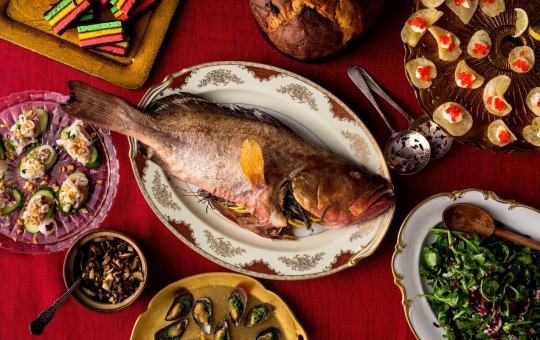
There are as many variations on the Feast of the Seven Fishes as there are participants. Menus often have changed drastically since the turn of the 19th century, but the object of cultivating family and heritage remains. Photograph By Andrew Scrivani, The New York Times/Redux
What is the Feast of the Seven Fishes?
This Christmas Eve seafood feast is an Italian American tradition that dates back to an immigration wave in the 1900s.
— By Allie Yang | Wednesday July 26, 2023
An episode aptly titled “Fishes” from Hulu’s breakout series The Bear explores complex family dynamics against the backdrop of an Italian American tradition: The Feast of the Seven Fishes.
Throughout the Season 2 episode, no one seems able to adequately explain its history. Characters attempt to contextualize the origins of the meal, with explanations ranging from “it’s tradition… the seven fishes” to “it’s a chance to be together and to take care of each other and to eat together, and there’s seven fishes, which means you have to make seven entirely different dishes, seven entirely different ways.” A discerning viewer will note the circular reasoning.
By episode’s end, the audience might leave with unanswered questions. Namely: What is the Feast of the Seven Fishes, and where did it originate?
Italian Origins
The Feast of the Seven Fishes is a dear tradition to many Italian Americans who enjoy (at least) seven different seafood dishes on Christmas Eve. You might find labor-intensive preparations of baccalà (salted cod fish), calamari fritti with lemon and marinara sauce, stuffed escarole, fried smelt, scungilli (conch) in a chilled seafood salad, and stuffed clams oreganata.
You won’t hear about “festa dei sette pesci” in Italy though, says Michael Di Giovine, professor of anthropology at West Chester University of Pennsylvania and author of Edible Identities. In Italy, the holiday is simply “la vigilia,” “the eve” of Christmas. And fish is really only eaten in Southern Italy on the holiday.
This is because the feast has evolved to be uniquely Italian American over the past hundred years.
At the turn of the 19th century, Italian immigration exploded, numbering 300,000 in the 1880s, jumping to 2 million by 1900. As Italian immigrants moved away from extended family and their children grew and married Americans, the Feast of the Seven Fishes evolved from la vigilia into something much more extravagant. Di Giovine says the feast was a way to differentiate themselves, a marker of identity. It also became a tradition to strengthen bonds with both family present and ancestors past.
Today, there are as many interpretations of the feast as there are participants, Di Giovine says.
Why Fish—And Why Are There Seven?
A vast majority of Italian immigrants to the United States were from rural Southern Italy at the turn of the 19th century. When the country was unified in 1861, they had new freedoms from a weakened aristocracy. They came to America because there were jobs (from building railroads to skyscrapers) and mobility. Friends and family found success and brought their loved ones to the U.S.
Some say fish was chosen for the Feast because it was plentiful for impoverished families in Southern Italy. Others say the sea represented Italian Americans’ connection between their old and new homes. Still others say fish was served simply because it’s seen as an aphrodisiac.
Though many families no longer associate the feast with Catholic tradition, there’s likely a religious explanation for the seafood. The first Christians used fish iconography to denote membership. In one biblical tale, Jesus procures a large catch of fish, and promises his disciples an abundance of followers when he commands them to be “fishers of men.” To this day, the Pope wears the “ring of the fisherman.”
Seven is also a holy figure: it’s the number of sacraments and deadly sins. In the Bible, Jesus miraculously feeds a crowd of people with seven loaves and fishes. “Consumed in multiples of seven, then, fish may be a deeply ingrained symbol of sanctifying and revivifying a plentiful group, and of promising continued abundance for posterity,” Di Giovine writes in a 2010 paper on the subject.
Tradition is Always Evolving
Italian culture is very regional, with small communities specializing in certain foods. North and Central Italy didn’t eat fish on Christmas Eve. The rush of immigrants at the turn of the 19th century were from the South, which has Spanish influences on the language and food. Fish, olive oil, vinegar, beans, tomatoes and fried foods like pizza fritta (pizza pockets) and zeppoles (donuts) are foods from the Italian South (notably not pasta).
In the 1900s, anti-Italian sentiment was high and Italians from different regions were lumped together by outsiders. Eventually, traditions also became melded together to produce the current Americanized image of pan-Italian food that ranges from pizza to cannoli, which are both regional in Italy.
After World War II, Italians were accepted members of American society. They moved (with everyone else) to the suburbs, their kids went to school with those from other backgrounds, and TV was popularized, homogenizing the population’s taste. Language and religion are lost quickly in this situation, Di Giovine says, and food could be a way to separate yourself that you could choose when to use.
Writer and director Robert Tinnell made a comic in 2004 about his experience with the Feast of the Seven Fishes, which he later made into a 2019 movie. Growing up in North Central West Virginia, he fondly remembers his great grandmother organizing the Feast. After she died, his grandfather and other men in the family took over. That particular masculine domesticity is something that the first Italian immigrants would have also performed out of necessity: men came to America first, without their wives and daughters.
However, knowledge about where to shop, when to prepare, how to cook, the history behind the meal, and family traditions quickly became the responsibility of mothers to pass down to their daughters, Di Giovine says. They are also likely the ones who have the ultimate say in making changes to recipes. Over time, families often tweak the menu to make things easier, cheaper, more abundant, and more accommodating of dietary restrictions.
“We’re not precious. I do a couple things that would have been on her table,” Tinnell says, referring to his great grandmother. “But then my wife loves seeking out new things. A few years ago, we picked up oysters and set them up outside over open flames; we roasted them in the shells. My family never did that. But I wouldn't trade the time that I spend with my father-in-law, my brothers, to all the kids—it's a new thing. And that's what's important here… that togetherness and that shared experience.”
#National Geographic#Culture#History#Christmas Eve#Seafood Feast#Italian 🇮🇹 -American🇺🇸#Fishes#Tradition#Michael Di Giovine#West Chester University of Pennsylvania#La Vigilia (The Eve)#Catholic Tradition#Southern Italy 🇮🇹#Fish Iconography#Spanish 🇪🇸 Influences#Pizza Fritta (Pizza Pockets) and Zeppoles (Donuts)#Cannoli#American Society#Robert Tinnell#North Central West Virginia
4 notes
·
View notes
Text
For #FishyFriday: examples of Ancient Greek terracotta red-figure fish plates. Can you tell by the designs which was probably made by Athenians and which by Greek settlers in southern Italy (Italiotes)? 🤔
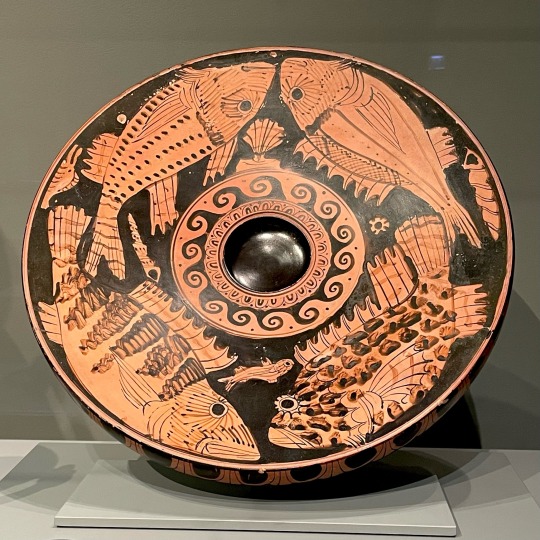

two plates on display at Art Institute of Chicago
The answer is revealed by the label for this 3rd example…

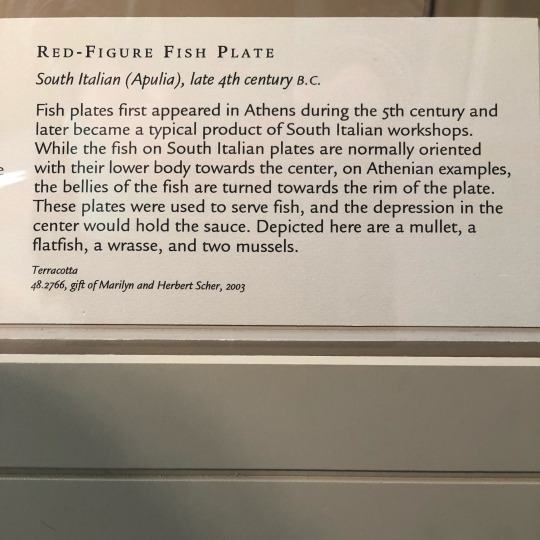
fish plate and gallery label on display at The Walters Art Museum
Answer: the first plate is Athenian and the other two are Italiote. The design clue is in how the fish bellies are usually oriented - towards the outer rim (the original Attican design) or center (the later Italiote design).
#1 Athens, 5th to early 2nd c. BCE
#2 Campania, 2nd q. 4th c. BCE
#3 Apulia, late 4th c. BCE
#fish#fishes#seafood#mollusks#molluscs#ancient art#Greek art#Athenian art#Attican art#Italian art#Italiote art#European art#terracotta#ceramics#plate#fish plate#red figure pottery#iconography#design#identification#Fishy Friday#Art Institute of Chicago#Walters Art Museum#animals in art
33 notes
·
View notes
Text
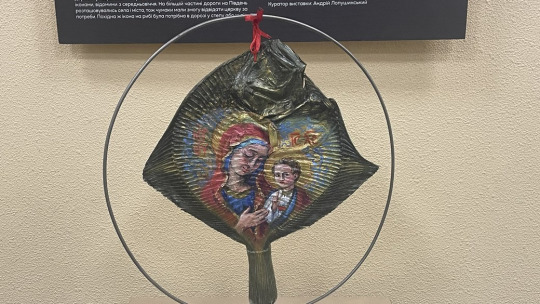
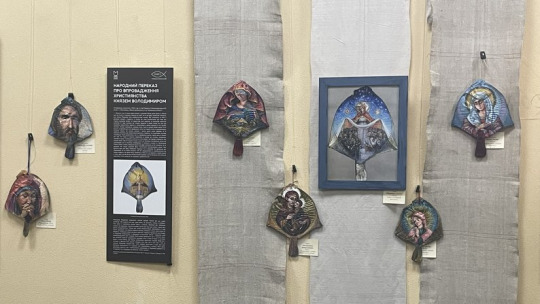
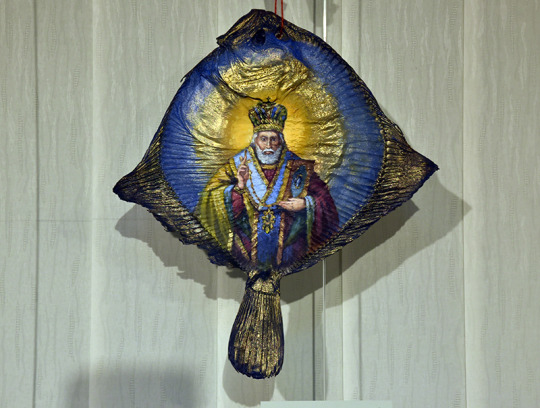
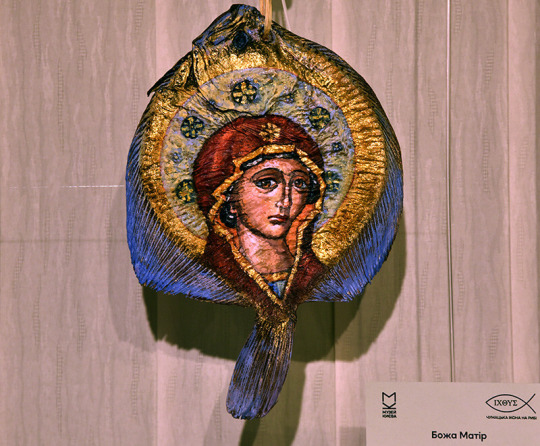

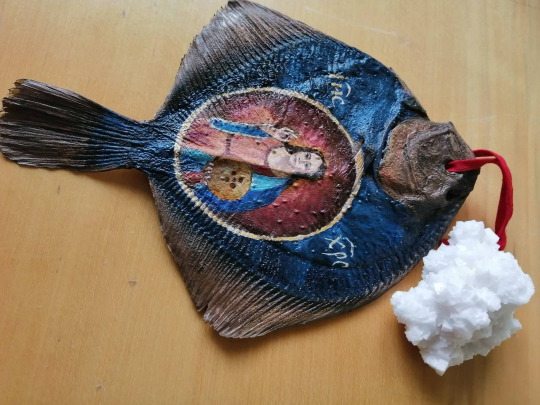
Because people seemed to like the original post so much, here are some more examples of chumak iconography.
Iconography on dried fish began to be painted in the 19th century by Ukrainian fish and salt merchants, called “chumaks”. They brought their goods from the Black and Azov Seas using carts pulled by oxen, and then sold them at street markets.
Chumaks spent a lot of time on the road. They attached such images to their carts, probably as travel icons, in the same way as some modern Christians place icons in their cars
It is possible that chumaks chose fish as the material for their icons not by chance, since the fish is one of the oldest Christian symbols. In Greek, ichthys is an acronym meaning “Jesus Christ, Son of God, Saviour”. It is also possible that the traditional wooden base was much more expensive than dried fish and quickly deteriorated under the influence of sun and precipitation
359 notes
·
View notes
Text
All The Colours of the GO Rainbow
Updated 11 Nov 2023
Edit note: I've done quite a big update on Red, Green and Blue, so if you read this before 11 Nov 2023 it might be worth reading it again.
I'm writing this meta about colours in the Good Omens AU in preparation for some future metas I'm planning, where colour will be important. And yes, I'm going to use "colour" as the spelling, as I'm an Australian and I use the UK English as my usual go-to version of English (that is what I was taught at school,) even though I am finding myself flicking between US and UK English here on Tumblr, leaving out u's here and there and putting in z's where I would normally put s's.
I also think its worth having another discussion about it as there are some colours I've have seen discussed here and there, but not at length, and some not at all that I think are important, and I just want to bring them all to one place.
I'm also going to be referring to @cobragardens excellent meta The Colors of Crowley quite a bit in this meta at various points, so you might want to pause and go read that first, then come back.
BLACK
Most people's initial reaction would be to class black as a colour of Hell. Crowley wears a lot of black, and usually a hidden accent of red (aaand something else. I'll discuss that at the end.) But the other demons are actually quite colourful when you get them into the light. They may tend towards the darker shades but there is quite a range of colours seen. Dagon, for example, is a very dark blue, as their avatar is a marine fish. Normally blue is associated with Heaven in GO. But this fits better if we think of black as being the colour of shadow, where the light does not reach, and the place of hidden things, of mystery

And it's worth noting that Aziraphale wears some black when he is trying to perform a magic show. He also wears white and gold at the same time but normally he does not wear these colours, unless he is performing human magic (see S1E1, Warlock's 11th birthday party, and the 1941 minisode S2E4) This should be striking enough for you to sit up and take note. You could say when Aziraphale dons black it is an expression of his act of "mysteriosity."
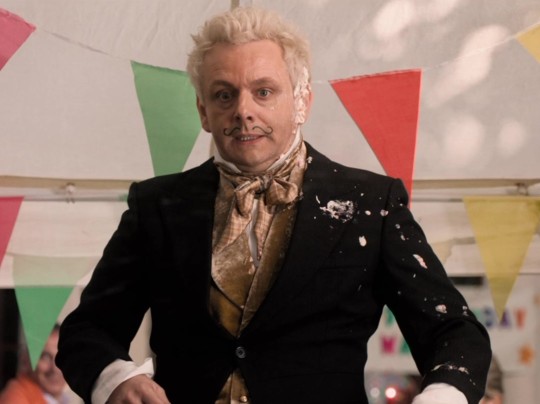

RED
Again, red is not necessarily a demonic colour, although we tend to associate it with demons, as Lord Beelzebub and Lord Dagon both wear red sashes as a mark of their rank in Hell. Think of it more as the colour of passion and romance in GO. Ooh, got you there! Makes you wonder what Shax is really up to (I know some of you have.) Perhaps they are just passionate about doing their job, or climbing their way to the top of the demonic ranking ladder?

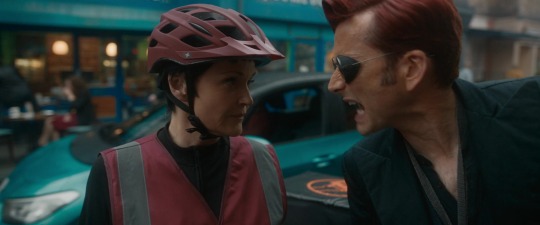
Edit: After writing up a couple of other metas and some more reading maybe a better description is "devotional passion." Shax is devoted to climbing the power ladder in Hell (her red is usually a darker shade of red than Crowley's,) and the Red Team in the paintball fight at Tadfield Manor in S1E2 is devoted to following the rules of Management. Crowley is devoted to Aziraphale, of course.
In Christianity red has an association with the left-hand side, or the sinister side. In GO we tend to call this the "demon side" as there is a lot of shot blocking for shoulder-angels and shoulder-demons. Crowley is typically on Aziraphale's LHS because of this, so when he isn't, we take note. Actually you should take note of all the shot-blocking in GO because who is on the shoulder-right and who is on the shoulder-left of shot tells you so much about their moral stance in that scene! Anyway, in religious iconography it will often be Michael robed in red, with a sword, on the left of Jesus, representing the eccentric, the strange, the excessive, fire - and goats. (Hey, goats are a whole other meta, we are here to talk colour!)
Special mention to the 1941 minisode in S2E4 that is just soaked in red, everywhere you turn: in the sparks flying off the burning buildings as the sparks of love begin to fly, the inside of the book shop where Crowley encourages Aziraphale to think like a professional, the magic shop where danger and chaos lurks in every corner but magic is Aziraphale's personal passion, and the Windmill Theater where he finally gets to perform his magic passion on the stage. Several ops see this as a special memory of Aziraphale's so he colours it with the red of romance. We've got big hopes of seeing a third part to 1941 in S3. Some of this red is also used as a metaphor for flames and fire (there always seems to be something burning after a gun is fired) - we are fanning the flames of passion again!


GOLD
Gold is one the colours of Heaven. Nearly all the angels have some form of gold on them at some point. A gold ring, gold embroidery on their clothes, a golden brooch, gold on their face, Aziraphale's gold watch fob (he has a ring, too). We also see multiple golden lions in various places, which appear to have a connection to Heaven and Jesus. (I'm still planning to write a meta on the lions in the future, but I've got to find them all first! They keep turning up in surprising places...) The lions have a royal connection, one of two royal mentions in this meta, in that they represent the connection Jesus has to the Royal house of Judah, and are a symbol of his return in the Second Coming.


YELLOW
Yellow in GO is probably the hardest colour to interpret. We see a lot of it, because Aziraphale is so fond of it, being the colour of Crowley's eyes. The walls of the book shop are painted yellow, he gives Jimbriel a yellow feather duster to use and he turns the Bentley yellow on the trip up to Edinburgh, much to Crowley's disgust. (To be fair, Crowley's Mayfair flat in S1 was colour-coded to Aziraphale's eyes in return, in greys and subtle blues, but that's another discussion.)
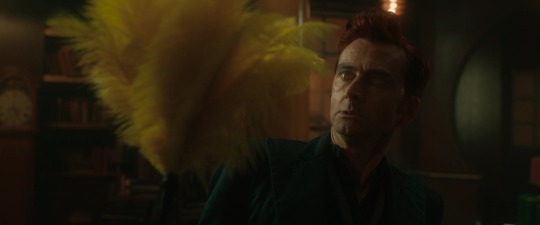
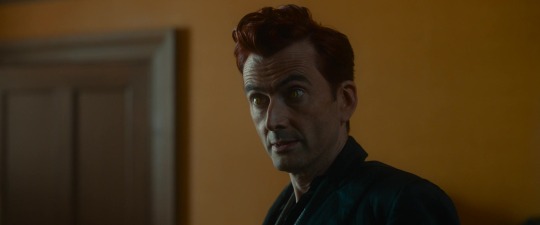
But I think the important thing to emphasis here is that yellow is NOT the same as gold, and we shouldn't blend the two colours together.
While some point out that yellow can be seen as an imperial or royal colour, as it is the colour of the Sun, when you put this colour in context in the GO AU, it more clearly points to being the colour of fear, as Cobragarden's explains in The Colours of Crowley. I would expand on their words, and say that is why Crowley doesn't wear his sunglasses in front of Jimbriel when looking after him in the book shop - its a measure of how afraid he is that the the real Gabriel might reappear at any moment. And back in S1 when Crowley is trying to work out how to escape the burning Odegra sigil he inadvertently created Hastur appears in the front seat of the Bentley in pursuit of him and reaches out to remove his sunglasses. The shock on Crowley's face in the moment is palpable, because he realises he's in the shit unless he thinks quickly - which he bravely does!
GREEN
Green is the colour of chaos.
Originally I wrote that Green was Hell, but on after writing this and going on to write further metas (I think I’ve mentioned this elsewhere, and this is an evolving meta) and a brief discussion in the Notes at the bottom with noneorother, I decided I would re-write this for a better fit.
It still fits Hell, however, as Hell is chaos compared to Heaven. It’s overcrowded, its clogged with bundled paperwork that hasn’t been filed, there is old furniture everywhere. It’s still the overgrown suffocating swamp of decay, with the leaking pipes and the light struggling to find its way down through the mess. It’s still Furfur, with plans to unexpectedly disrupt our hero’s magic act. It’s still the colour of the fog outside the bookshop during the Eldritch Ball, signalling that things are not going to plan. Demons love chaos, its their purpose. It’s the opposite to Heaven, which is rigid and structured.
A recent post from @noneorother highlights that the intense green used for Hell in S2 is influenced by the the Powell & Pressburger movie The Tales of Hoffmann. They say:
Whenever something evil happens in "The automaton ball" sequence, the light changes to this sickly green. Colour is THE important symbolism in Hoffmann, so now we know green is evil.
But they wanted to add that evil is not necessarily Hell. And we would have to agree. Because Aziraphale also has a lot of green associated with him, and he has nothing to do with Hell - he's more an agent of chaos, if anything. He's unpredictable. Let us address this in it's own section below.
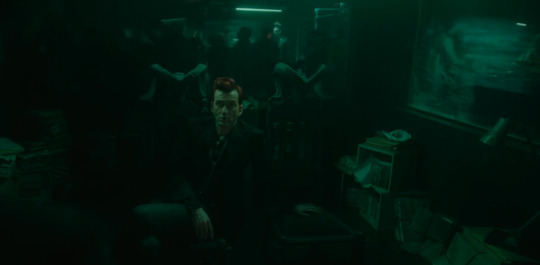
Veridian/Teal/Aquamarine
This is a special section to discuss the blue-green hues that Aziraphale wears. Heaven mixed with Hell. Lawful mixed with Chaos. He is one unique angel. The first sight of these colours is in 1601, when we find out that the Arrangement first proposed by Crowley in 537 is now in full swing, where he has some teal strips in his Elizabethan costume.
While I'm told its traditional to have a darker colour on the back panel of waistcoats, it's notable that the back of Aziraphale's waistcoat is a distinctly dark viridian green. Why not dark blue? Or a shade of brown to go with the other shades of brown and beige the angels tend to wear? But what's the meta-writer's motto in GO? There are no accidents...

He also wears a pale aquamarine shirt in the present day. (wearecrowley has posted a nice set of GIFs that highlight it here) No white for him since 1941 at least, although his 1821 shirt also looks green to me, but its hard to tell in the dim candlelight of night time Edinburgh (unless he is performing magic, then he is in white, gold, and mysterious black or being discorporated, then he is colourless white - back to his "native" state, like Muriel in her Earthly Inspector uniform.) The cape he wears in the 1941 minisode is also a fascinating colour. I am having trouble pinning down exactly what it would be called - Teal? A darker aquamarine? Perhaps turquoise. It's certainly part of his colour palette, and still indicating a lawful-chaos mix. A "dark horse" indeed!

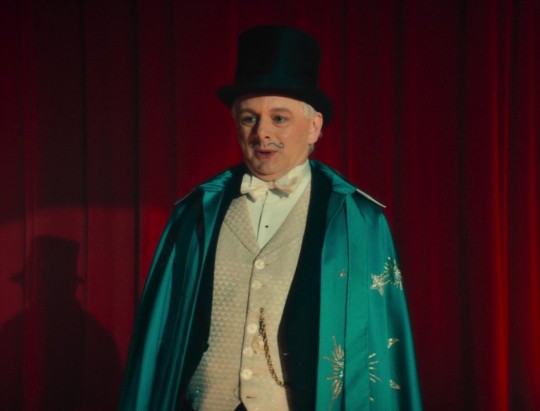
[Edit: So i saw someone describe Heaven and Hell as Lawfulness and Chaos, and I thought that was a perfect fit for Aziraphale here with his blue-greens. Remember Crowley described him as "unpredictable" to Nina? Yeah...]
[Edit 2: I've made some changes above because I re-wrote the section on Green. This is an evolving meta!]
BLUE
Blue is a signal of Heaven, the colour of the sky, and a colour traditionally associated with the archangels Gabriel and Michael. We see it in a number of places, in both S1 and S2, where it is used with deliberate care.
Usually a primary shade of blue, this represents the rigid lawfulness and rules of Heaven, as compared to the chaos associated with Hell. In Christian iconography blue is what Gabriel wears as the right-hand-side shoulder angel to Jesus. It represents the Law, mercy, protection, water, sheep(!) and foundation. The "good" shoulder angel is always on the right shoulder in shot-blocking in the show.
Below are some examples of where we see it:
The blue paint on the back of Aziraphale's coat when he gets hit by a paintball at Tadfield Manor in S1E2.
The colour of Newt's car, Dick Turpin (which actually presents an interesting juxtaposition, as Newt is a Crowley parallel.)
The colour of the external walls of the coffee shop in S2, and some of the inside, which is also the same as the take-away cups, such as the one the Metatron offers to Aziraphale.
The colour of the gecko Jemima asks to be turned into in the Job minisode.
The colour of the suit Jimbriel wears at the eldritch ball, and the glorious ostrich feather jacket he dons when he exits the book shop to give himself up to the demons.

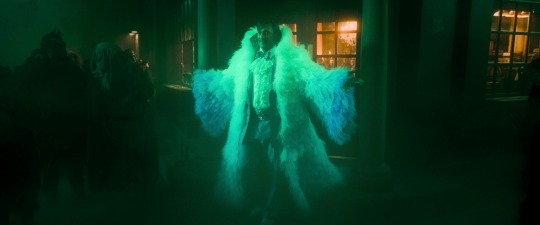
PURPLE
Purple has long been the colour of royalty, since ancient days. This was for good reason - there was only one natural source of the rich purple dye. That came from a small marine snail that was found on the coast of modern day Lebanon, near Tyre, and they held the monopoly on this trade for centuries. Only kings and emperor's could afford to have cloth dyed in this colour, known as Tyrian purple. It wasn't until the first synthetic purple dye was created in 1856 that the common man could afford to wear it as well.
In Good Omens we see Gabriel, the Prince of Heaven, wearing this colour in his ties, and also showing it in his irises in both S1 and S2. But only when he is Gabriel, not as Jim.
[Edit: So I only just found out that the colour he wears is lilac and is modeled after Elizabeth Taylor's famous eyes. But hey, she was a queen of the screen - movie royalty! And you still need to explain all the other purple below. Also, she was only born around 100 years ago and Gabriel has theoretically been around for...a lot longer, so I'd say Gabriel came first.]


There are a couple of other places we see it used. One is when angel Crowley starts up his nebula. The plume of miracle energy emanating from the book shop after the 25 lazurii miracle is also this colour.
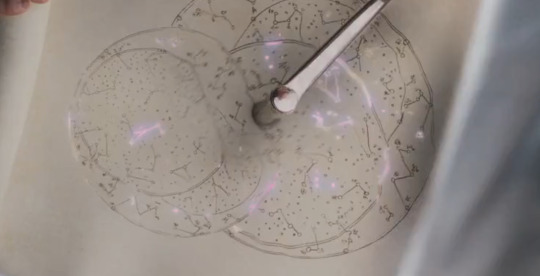
Archangel Saraqael's chair is purple when she is on Earth. And Saraqael and Muriel both have purple in their tartan when in Heaven.

WHITE
White is the colour of the angels. It is the colour of Aziraphale's wings and the colour of his robes during ancient times from the Beginning up to Rome. Once the Arrangement starts, the white starts to be replaced with other colours, and the shades of teal and other blue-greens start to appear.
By the present day he has virtually lost all trace of white, except for his hair. He then only appears in all white when discorporated.
Muriel turns up in a conspicuously bright white police uniform on Earth, and the other angels all have some form of white on them.
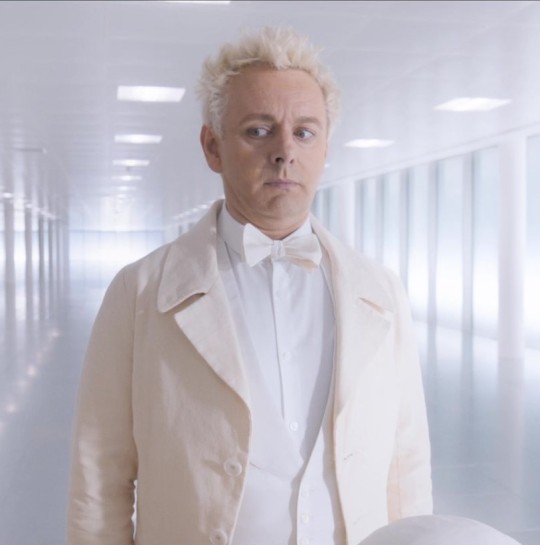
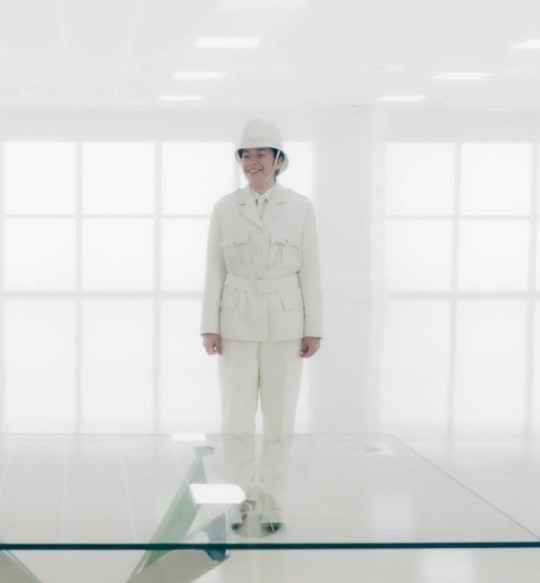
Crowley sometimes has small accents of white as well. They can be easily missed, such as the white shirt cuff protruding from his sleek black Elizabethan costume in 1601. Remember they are discussing the Arrangement here - so they are both showing signs of taking on each other's colours at this point. On the other hand, I know quite a few people have commented on the white in his 1941 garb, on his tie, and his pocket handkerchief (and remember, he wears a grey shirt, not black, because he doesn't want to be mistaken for a black-shirted fascist during the war years.)


SILVER/GRAY
There are two colours I keep seeing that I'm going to group together as one, and that is silver and gray.
The senior archangels are notably dressed in what I've seen described as dove-gray, but an article on the costumes calls it pearl-gray, and it was meant to look a bit shimmery. I sometimes refer to this group of angels as the Archangels with the capital A, or the seraphim, the closest angels to God. This includes Gabriel, our current Prince of Heaven, Michael, Uriel. And I'm going to include Crowley in his trademark Tactical Turtleneck master spy disguise when he infiltrated Heaven with Muriel in S2E6. Hey, he could have worn white!


So where does this colour come from?
I've spent a bit of time banging on in the past about "traditional colours" of the archangels, in particular Gabriel and Michael's being blue, and the missing Raphael's being green. Part of the problem is, though, if you go looking online for who's colour is whose, you get a big variation in answers. Michael nearly always comes out with being associated with blue, and Raphael with green, so no problem there, but all the other traditionally named seraphim seem to get other colours put against them. For Gabriel, though, a commonly associated colour does appear to be white or silver.
Now my guess would be that sparkly silver would be too naff a look for the angels. I mean, look at what Crowley manifests as a blending-in "bees" disguise, a slightly shiny grayish suit, which kind of mocks the other Archangels (and you're overdoing the gold hints there a bit, Crowley) but it is curiously the same style as Saraqael's garb, and they did supposedly work together on the Horsehead Nebula. Hmmm. The Archangel's pearl-gray suits look very corporate and business-like, echoing a large soul-crushing business entity.
But this is not the only time Crowley wears this upper echelon colour; he has quite a habit of wearing it, particularly once the Arrangement kicks in.
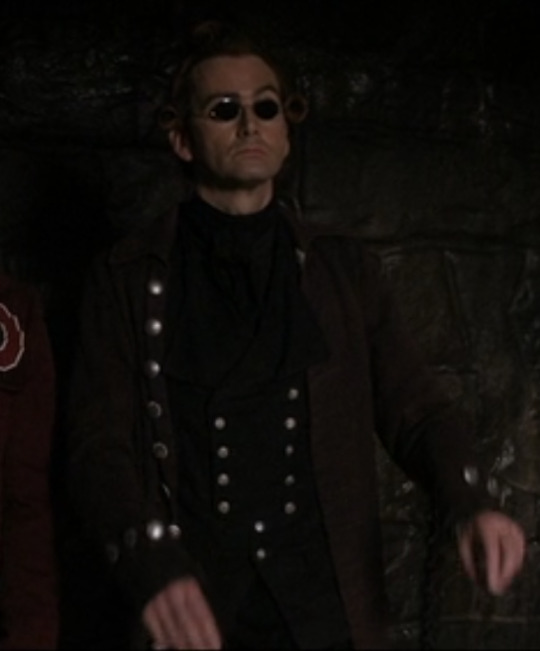
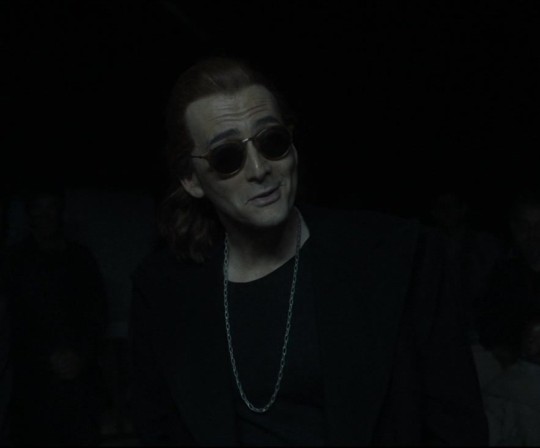
The problem is, he nearly always wears near-solid black (unless he is trying not to get killed, like in 1793 Paris - Cobragarden's meta on the context why here - or 1941 London - see above,) so it stands out. I find this a far more interesting than the red accents, and should note that we don't always see it on him; its not there in 1967, for example.
One colour that is noticeably missing in the full GO rainbow is orange. We don't get it handed to us on a plate as much as the other colours do. Perhaps one exception is the sign for The Resurrectionist pub in Edinburgh, where Jesus is wearing an orange robe under a blue cloth. [Edit: It must be my screen colour, its been mentioned to me that the under-robe is actually crimson red.]
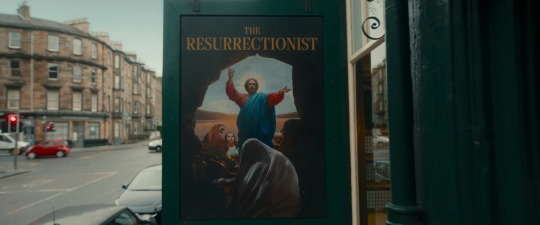
So now we have run through all the colours, it can be interesting to look at them in combination.
Bonus points for noticing the white mugs for the S2 coffee shop (six-shots of espresso,) to go with the blue take-away cups. The shop is blue-white-gold themed. Truly meant to be a place where Heaven is obtainable on Earth! It also kind of reminds me of the sky - blue sky overhead, white clouds, and a golden Sun shining down (from the brass lamps.) [Edit: There is a paler green inside the coffee shop - its easy to miss, we are too busy watching the characters!]
The book shop also has a combination of colours - predominately red and yellow. Yellow for fear, and red for passion and romance. Ouch, what a combination!
Aziraphales's white, gold and black combination for performing magic also has me intrigued. It's not just the black, but so much golden colour in the form of a golden vest. And we get it both times in both 1941 and 2019. An angel from Heaven trying to hide what he really is.
I've added an extra section below as part of a reblog on the angel off-whites and shades of brown that also appear, as I realised I missed them, and do a character analysis of the Metatron, so make sure you read that as well.
If you are interested in my analysis on the tartan in GO I've one here at: What the Tartan Tells Us
For further meta reading on colour in GO try the following:
If you haven't read it yet, do go and read Cobragardens The Colours of Crowley, Red and Yellow can hurt a fellow: Colour Symbolism in 1941 Part 1 and Part 2 as it makes the colours more character specific, whereas I've tried to give the colours a more over-arching theme here.
And for the importance of the yellow colour Vavavoom! which is used on the book shop walls, (and matches Crowley's eyes) see Vidavalors post on The Vavoom: Or, when the show's hinting Crowley & Aziraphale first kissed
#good omens#good omens 2#crowley#aziraphale#good omens meta#good omens analysis#gabriel#shax#muriel#color#colour#colors#black#red#gold#yellow#green#viridian#blue#purple#royal purple#white#silver#grey#dove grey#archangel#archangel gabriel#prince of heaven#maybe you'll spot an archangel
96 notes
·
View notes
Text
Okay, ever since the concept art of the Mario Brothers movie got leaked on Reddit, I've been wanting to make this post. And I think now is the time. Gird your loins friends. I am about to overanalyze the hell out of thirty seconds and one concept art of a movie.
A Room of Their Own: An (Over)Analysis
To start with, I want to justify this whole treatise by comparing the concept art of Mario and Luigi's room with what we get in the movie.
Concept Art

Movie
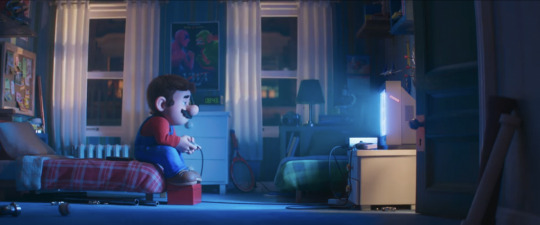

These match up incredibly well. There are a few poster swaps on Mario's wall, the generic baseball team versus an obvious reference to the Mets (a point I'll talk about in a moment); Beastie Boys for the fish person poster (and it's bugging the hell out of me, because the green guy is wildly jogging my memory and I can't quite place it). Luigi's side of the room also gets slightly rearranged, although the objects are mostly the same, minus the swap of the anime mecha figure for an art mannequin.
Now that we've established continuity, let's talk about why we're exploring this in the first place.
I love analyzing people's living spaces in media. They tell such an intimate story about who a person is, what they value, what they're hiding, and so on. And the snippets we get of Mario and Luigi's room, both through the movie and the concept art, say so much about them and (arguably) connect in some measure back to the games and even the cartoons of my youth. So, let's dive in, shall we?
Mario
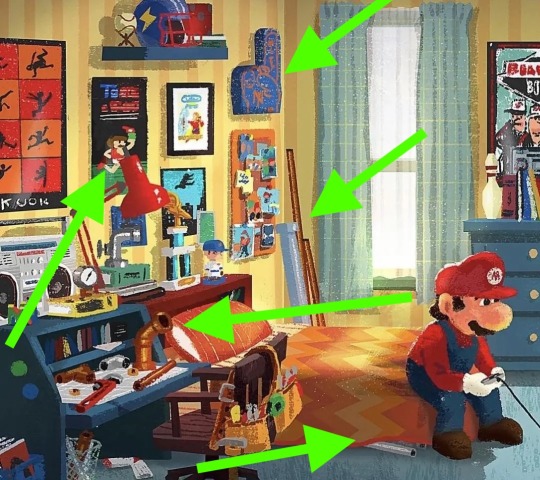
In both the concept art and the movie, a couple of themes emerge from Mario's side of the room.
Plumbing
It's obvious that Mario's passion is plumbing. There are pipes sticking out from under his bed, pipes stacked in the corner, books on plumbing stacked on his desk, along with all kinds of other related paraphernalia. Regardless of Spike or his father, Mario seems genuinely into plumbing as his vocation (remember, he was the one who was the driving force behind that commercial). Keep this in mind for when we talk about Luigi, because there's a divergence there.
Sports
We know from the movie and general lore that Mario is quite athletic, and seems to enjoys sports. Here, we see posters for baseball and what is presumably the New York City marathon (at least in the movie still); we see a football helmet and some small trophies that one might assume are related to his own sports activities. Is he the absolute, number one winner in all of Brooklyn? Unlikely, given his insecurities about always being "small," about wanting to amount to something. This being said, it's obvious he has some prowess and accomplishment in the world of sporting, perhaps on a high school level. And the whole parkour scene shows that he trains, keeps himself in shape for this type of thing. (As an aside, can you blame Luigi for not being able to keep up? Forget the knees, he's hauling a 15-20 pound bag of plumbing equipment with him! Give the guy a break).
Anyway, this is all unsurprising for our hero archetype. The marathon poster - grit and determination. Baseball and football - all-American sports. Central casting, call one wannabe hero. (Remember, what people showcase in their rooms is generally what is important to them, what they value).
There is a small wrench thrown in here, however (ha! a pun!) And that would be the foam finger featured in the concept art which is a very familiar orange and blue. And that along with the baseball figurine and posters - which have similar coloring and iconography of the intersecting "NY" - lead me to believe that Mario is a Mets fan.
Now, I need make a small digression here to explain why this is important to his character.
The Mets are the long-suffering little brother to the perennially-successful New York Yankees (booooooo). They still hold the modern era record for most losses in a season (their inaugural year, 1962, where they went 40-120). Over the decades, they have been plagued by inept ownership, catastrophic end-of-season collapses, and bizarre events that can only be categorized as "LOLMets." (This Reddit thread is a particularly entertaining history of the franchise's tragi-comic moments).
And aside from being a lifelong masochist fan of this team, I think it's important to bring this up in terms of Mario's character because he sees himself as the underdog while in Brooklyn; as little, as constantly underachieving. It's extremely fitting for Mario's movie depiction that he roots for the eternal underperformer, for a team that has historically been supported by the more blue-collar areas of New York, a fanbase which suffers year after year and yet always comes back for more.
Mess
This is actually my favorite part of Mario's section. Canonically, Mario is a kind of a slob. In both the concept art and movie stills, we see plumbing bits and parts strewn all over the place, pipes shoved underneath the bed, pipes stacked in the corner, half-finished projects and tools running amok his desk. (Note, he's not dirty, just disorganized).
And the thing, this isn't the first time we've seen evidence of this. Luigi, on two separate occasions, either complains about or encounters his brother's habits in the Luigi's Mansion series. (Although the first quote below could be more of a commentary on Luigi's persnickety-ness rather than Mario's laundry habits).


(seriously, Mario. Just how many pizzas did you need?)
There's something...I don't know, endearing or somehow fitting that the titular hero of the Mushroom Kingdom is a domestic disaster. Almost as if whatever energies he can muster are focused solely on hero-ing and plumbing and anything else just...falls by the wayside. (Understandable. There's only so much all of us in our lives have energy for. You have to prioritize). Still, it sets up this contrast between the front Mario puts up and how he's received by the Mushroom Kingdom and who he really is, which he definitely reserves for a select few closest to him, the prime candidate being his brother.
And speaking of that brother...
Luigi

It's unfortunate that we don't get as many quality shots of Luigi's side of the room in the movie, but from what can see, the concept art is pretty consistent with the film.

And I'm being adamant about the consistency of the concept art and the movie, due to the fact we get so little Luigi screen time and yet his room tells us so much about him.
Science
We've got a tech-mech boy here, my friends. Note the somewhat advanced microscope perched on the headboard, the calendar of the motorcycle, the schematic of the racing car, the little jet-rocket ship. Note, in the concept art, the mecha sat prominently on top shelf.
Now, what does this tell us? (Aside from the fact Luigi is a total nerd, which we knew already).
Firstly, Luigi is very into motor vehicles, science (fiction), and possibly robots. That he possibly has some interest in engineering and robotics. This may sound familiar.

Yes, the Super Mario Brothers movie, by intent or not, kept Luigi's mechanical engineering interests intact. (There's a whole other post in here where I could provide further proof of this outside of SPM. I suggest watching the SMB 3 cartoon episode, "Mind Your Mummy" which not only wildly showcases Luigi's engineering skills, but is pretty hilarious).


But I digress.
Here's the interesting contrast. Mario is obvious about his passion for plumbing. Luigi, although canonically more reserved, does take the effort to highlight what is important to him in his room - namely his interest in science and engineering (and photography, which we'll talk about in a minute).
It makes you wonder...Luigi is not a confrontational sort. He goes along with what Mario does because he loves his brother and perhaps he either doesn't know what he wants or is afraid to express it. I personally doubt Luigi's true passion lies in plumbing, from what we see here. It's a means to end.
Now, whether Luigi disavowed engineering due to finances, low self-esteem, family pressures, or if he just wasn't ready to declare who he was...we don't know (I would posit it's some tasty combination of all of the above). But I do feel like it's fair to say Luigi is along for the ride at this point. He loves his brother, is possibly a little too dependent on him. It's not like he's bitter about it (well, on the surface. The Mr. L persona raises some interesting questions) - he's just doing what Mario does because...that's what he's always done. Luigi hasn't found his true footing yet. (You can even look at the fact he carries the toolbag throughout the movie as a kind of metaphorical weight of Mario's interests and goals over his - which, I realize, for a Mario property, is a reeeeeaaaaal stretch. But since I'm overanalyzing three stills from an animated movie about video game plumbers, I might as well go for the gold).
The other aspect of Luigi's interest in fast cars, fast bikes, and fast rockets is how that contrasts with his reserved nature. Luigi is, supposedly, the scaredy cat, the one who won't take risks. And yet what we see fascinating him the most are chunks of metal being hurled through time and space at ridiculous speeds. Wish fulfillment? Or maybe another side of Luigi that even Mario doesn't always get to see.
We also see two ribbons pinned to the wall near the sciency/tech items. Most likely, this had to do with academic achievement I would bet good coins that these achievements were in STEM. Again, Luigi is showcasing this, meaning it's important to him.
In this context, him gravitating towards E. Gadd and his experiments is wholly in-character, despite Luigi's (understandable) anxiety about dealing with undead (but does he say no? Much like his rocket cars, there's a kind hidden recklessness to his character). Mr. L and his robot obsession (and skill) make perfect sense. Luigi's probably been looking for that kind of outlet for quite some time. I can pretty firmly state that the engineering aspect of Mr. L was not brainwashing and it makes you wonder if the other facets of Luigi's personality that rise to surface during that whole episode were planted or there already, just suppressed.
Cleanliness is Next to Godliness
Luigi is just a bit of a neat freak. We see this in the hat-cleaning episode referenced above, in the way his side of the room is somewhat meticulous in its organization (in contrast to his brother). He also has a few hilarious quotes in the original Luigi's Mansion that are worth including here that really highlight this side of his personality:
Now that I look at it-- it's full of moth holes! Yecch!"
"So much dust! This will never pass the white-glove test!"
"Well, they sure did pile odds and ends everywhere… Filthy."
"I should probably give that a quick vacuuming…"
"Oh, what's this?! Just how I like it… Nice and clean!"
"Do Boos wash their faces?"
And what I find interesting about this tendency toward order is how it relates to Luigi's anxiety. I would argue that part of his clean streak is an attempt at controlling his environment, a way to counter that ever-present anxiety. It also seems fitting for the engineer to be far more fastidious about things being just so. Yes, it's a bit of a stereotype - a trope, if you will - but one that might have some teeth in this situation. After all, if you're building race cars that go ridiculous miles per hour, there's no room for error. I think the contrast between the two brothers - Mario's outside world is consistently on the edge of chaos while Luigi's inside world is the one on the precipice - is fascinating.
Sports
Now, it's not like Luigi has zero athletic ability (despite his complaints). We see a tennis racket in his room and a dartboard. He helped Mario beat up Bowser with zero training montage. It's just that Luigi seems to gravitate towards athletic endeavors that require more pinpoint accuracy (not that baseball and football don't, but it's a little different in my mind) and that avoid almost all risk of physical collision. Again, those interests are not what we think of as "stereotypical" of the big hero. And Luigi is a hero, but in a very different way than his brother.
Camera
I don't have too much to say about this one, but I think it's delightful that Luigi owns and uses an old-school camera. We can actually see two black-and-white photos pinned to his wall in the concept art, showing us Luigi's more artistic side, which is kind of neat (and let's not forget the movie subs in an art mannequin for the mecha, which only strengthens this notion of art interest. Maybe he's into the notion cybernetics? It's possible). I suppose I could read into camera thing as an observer vs. participant dynamic (Luigi behind the lens observing while Mario is always in the action), but I wouldn't make an argument any more in-depth, and even that statement is a bit of a leap in a document chock-full of leaps.
Conclusion
If you're expecting a thesis out of this, I'm sorry to disappoint - I don't really have one. I suppose this whole rundown is more of a literature review than anything else, but what I do want to stress is what can be read from the objects in the room and their placement. I can't and won't pretend to know the intentions of the artists here. It's very possible there was far less thought put into the design and layout of these rooms than the long treatise I have just given over to it. This being said, because there is a fair amount of consistency between the concept art and the movie and because there is a fair amount of subtle character moments throughout the film (which have been broken down by other intrepid Tumblr friends), I might lean towards the notion that these design choices do have some degree of intent in subconsciously shaping how we, the viewer, read the brothers.
(And yeah, maybe I just wanted an excuse to pin more evidence onto my "Luigi wanted to be a mechanical engineer and is actually really skilled at robotics and other science" conspiracy thread bulletin board :D
#hello there#luigi#mario#meta#in which i overanalyze the hell out of a piece of media#and give myself an excuse to not only promote my luigi-engineer agenda#but also talk about baseball for a paragraph#hahahaha#self indulgent nonsense#smb movie#you guys asked for it
182 notes
·
View notes
Text
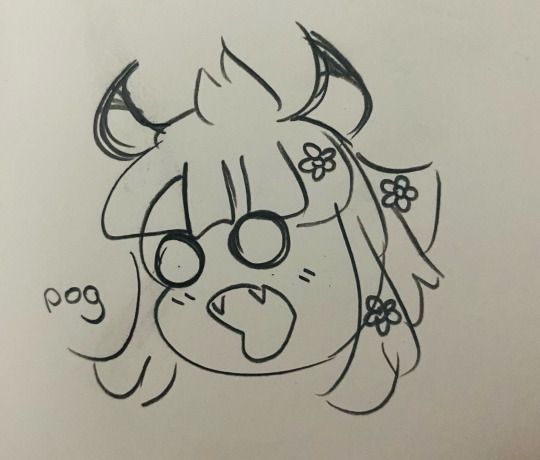
some notes on Taranza & Joronia’s species, and on Floralian culture:
🌸 Colloquially speaking, both bug-folk (Waspiders, Antlers, Sectra Dees, etc.) and plant-folk (the People of the Sky) are indigenous to Floralia, having lived there for thousands of years.
🌸 The floating archipelago’s Mirror Counterpart is the kingdom of Sporalia - an underground civilization deep beneath the earth, within and around Cabbage Cavern.
🌸 Floralian Waspiders are arboreal, whereas Sporalian Waspiders are fossorial. As a result, the latter tend to have thicker claws and larger horns, which they use for digging.
🌸 Both can hold their breath for significantly longer than, say, the average Waddle Dee - an advantage in dizzyingly high-altitude floating islands and waterlogged underground caverns alike.
🌸 Waspiders are omnivorous. Although their diet is particularly heavy on insects, meat and fish, they’ll also consume plants, fruit, flowers and flower nectar. Plant milk is popular, as are fruit juices and liquors, pulque, and cacao-based drinks.
🌸 Insects and other forms of prey are usually cooked, but consumption of raw or live prey isn’t unusual, either - the late Queen Joronia was particularly known for her fondness of raw shrew, sliced thin and marinated with fresh herbs, citrus and birch syrup.
🌸 Snakes are sacred animals and symbols of protection to Floralians, made in the image of their serpentine deity, Togu Ro Garāga (whom you may know as Coily Rattler). Killing, eating or otherwise bringing harm to a snake is taboo.
🌸 Statues and other iconography of serpents are often erected outside tombs, temples, homes, and so on - some, like the Burner Guardians, are even animated with magic to defend against intruders.
🌸 Floralia has a strong and elaborate tea culture - or rather, tisane culture! (Taranza is anal about the difference, but enjoys both.) Most Floralian teas are brewed from flowers and herbs rather than tea leaves, which are an imported delicacy from the Lower World.
🌸 Flowering teas are quite popular, consisting of dried flower bundles that ‘bloom’ as the water heats up. For those who prefer sugar in their cup, teas (and tisanes) are typically sweetened with honey, agave or flower nectar.
41 notes
·
View notes
Text
FRUIT FEARS ME, WOMEN WANT ME
TO FEED ME FRUIT
I DO NOT KNOW WHAT THEY GET FROM THIS ARRANGEMENT AND ATTEMPTS TO UNDERSTAND THEM HAVE LEFT BOTH SIDES FRUSTRATED
DOGS ARE CONFUSED BY MY PRESENCE AND SHOW SPONTANEOUS INTEREST IN RELIGIOUS ICONOGRAPHY AFTER MEETING ME
BIRDS CANNOT SEE ME
FISH HAVE REPEATEDLY REFUSED TO RESPOND TO MY CLEAR, NON-CONFRONTATIONAL REQUESTS FOR DIALOGUE
I AM WANTED IN THIRTEEN STATES, BY SIXTEEN OTHER STATES
I WANT FOR NOTHING EXCEPT NOTHING ITSELF
46 notes
·
View notes
Text
For black history month, I think we should begin popularizing monsters from the African continent the same way European monsters are overpopularized. To that end, here's a list of some of the most famous folkloric figures from Africa!
Mmoatia
Origin: Ghana (Akan)
Creature it is not: Dwarf
(Singular: Aboatia) Mmoatia are a subclass of abosom (spirits in between Man and Creator) that live in the forests of Ghana. They are short, have curved noses, backwards feet, and a unique language made up of only whistling sounds. Whistling in the forest is a sure way to get their attention. According to legend, they are phenomenal herbalists that will sometimes share their knowledge with humans. When a person gets lost in the woods, they are said to have been taken by Mmoatia. Humans who come back after being taken will become incredible medicine men. In Ghana, Dust Devils are called "Mmoatia Mframa" (Wind of Mmoatia) because they are belived to be a portal to their world similar to how fairyrings are treated in Ireland.
Mmoatia are divided into three tribes: Black, White, and Red. Black Mmoatia are supposedly harmless, while White and Red ones are always up to some kind of mischief.
Adze
Origin: Ghana (Ewe)
Creature it is not: Vampire
In Ewe culture, the Adze is a type of demonic spirit associated with witchcraft. They take the form of a fire fly that, during the night, crawls inside human beings in order to posses them. People possesd by the Adze are said to be witches, who use the spirit to slowly drain the life force of people that they envy (Old witches target the young, Poor witches target the wealthy, enslaved witches target their masters as they should).
When targeting a person, the Adze will leave it's host human during the night and crawl into the house of the victim. When it's close, it will drain blood from the victim like a mosquito.
Werehyena
Origin: Pan-African
Creature it is not: Werewolf
Just like how there are Werewolf stories all over Europe, there are Werehyena stories all over Africa. Compared to werewolves, which are said to be men cursed to be monsters, Werehyenas are actually monsters that disguise themselves as humans only to eat it's friends during the night. The people most likely to be werehyenas are village outsiders and blacksmiths, who are associated with magic.
In Angola, there is a similar (but not the same) creature to the werehyena called the Kishi. It is literally a two-faced demon that has a handsome man's body and face in the front, and a hyena's face in the back. This creature lures unsuspecting women into relationships so that it may eat them. If the Kishi has any male children with it's prey, it teaches them the art of femicide.
Mami Wata
Origin: Pan-African
Creature it is not: Mermaid (ok, it kinda is a mermaid but I need to keep the joke running)
Even more wide-spread than the Werehyena, Mami Wata is a figure so popular that it is common for water spirits in Africa to be retroactively labeld as Mami Wata and take on her iconography.
The most famous picture of Mami Wata is actually a french painting of a black Caribbean snake charmer, who west africans later identified as Her. Mami Wata is worshipped as a powerful, female river spirit that controls the flow of the river, the rate at which fish can be caught, the money that men can make, and several other things important to humanity. She is also said to be a seductress, who sleeps with unsuspecting men only to later kill them for cheating on their wives. Indeed, Mami Wata is a defender of women and a slayer of sinful and abusive men.
In many places, it is common to believe that women who drown or go missing in bodies of water were taken by Mami Wata to be taught magic. The women who return become pristessess to her, while the women who never come back become new Mami Watas.
Impundulu
Origin: South Africa (Zulu)
Creature it is not: Thunderbird (no hate, Thunderbird gets constantly thrown into things where it shouldn't be by people who don't understand it. And those people tend to be not native)
Impundulu, or Lightning Bird (NOT THUNDER BIRD), is a person sized Hamerkop bird that has the power to control the weather and summon lightning. It is also creature of evil magic, allied with witches and it has a never ending hunger for blood. It is said to sometimes take the form of a handsom young men in order to seduce women (why dose that keep happening).
Impundulu are immortal, and the ones that serve as witch familiars are passed down in the family as the old master dies and the child becomes grown. The bird is immune to gunshots, stabbing, drowning, and poison. It's only weakness is fire.
#black history month#west african mythology#west african folklore#african fairy#african fantasy#fantasy#africanjujuism#dnd#d&d#mmoatia#adze#werehyena#kishi#mami wata#impundulu#blackblr
22 notes
·
View notes
Photo
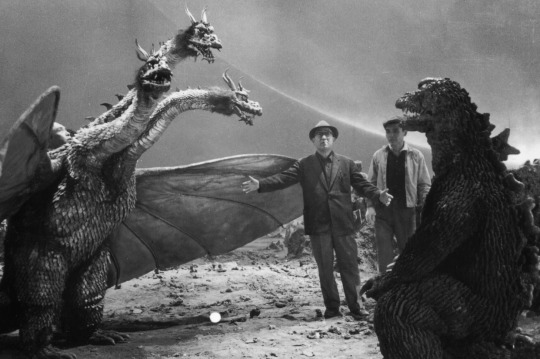

Tsuburaya Eiji, the Father of Tokusatsu
Eiji Tsuburaya made it possible for Godzilla to stomp across the screen and later on, Ultraman. A director, cinematographer, and producer, Tsuburaya is best known for creating the special effects behind Japanese classics like Godzilla and other giant monsters called kaiju.
And his legacy extends beyond those monsters — he built a foundation for film culture in Japan and special effects worldwide.
Before World War II

Tsuburaya grew up in Sukagawa, Iwase, a son of a prominent family of grocery distributors. A prodigy from a young age, as a kid he was interviewed about his model airplanes and credited in local newspapers as a "child craftsman." Shortly thereafter, he was captivated by a new technology called motion pictures — and he combined his two passions by taking pictures of planes.
But it was 1933's King Kong that led to his greatest professional epiphany. King Kong's giant title character and phenomenal special effects opened up a new world of possibilities for Tsuburaya. By studying a copy of the film, Tsuburaya managed to reverse engineer how the effects were made. Then he was ready to begin creating his own legacy.
Being a film revolutionary wasn't easy with his early battles over budget and setup, but when a new company called Toho Motion Picture Company was founded in 1936, Tsuburaya jumped on board to lead the special effects department.
After World War II
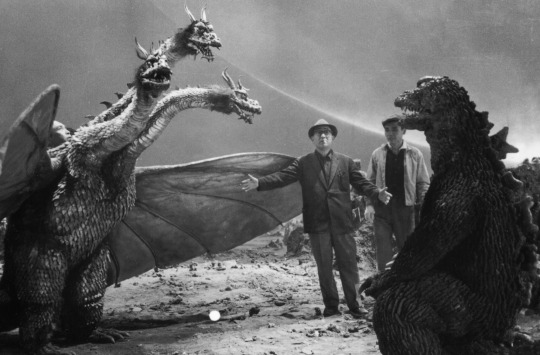
After being drafted to work on propaganda films in World War II and experiencing the napalm bombing of Tokyo, he returned to work at Toho after the end of US occupation in 1952, keeping a low profile because the US believed he'd committed espionage.
It was in that climate that producer Tomoyuki Tanaka was artistically inspired by the fallout of a US hydrogen bomb test in the Marshall Islands. The real story of a radiation-poisoned fishing crew inspired him to pitch a monster movie to Tsuburaya and Toho. After some creative wrangling, Godzilla was born.
For Godzilla, Tsuburaya made the bold choice to use miniatures and visual effects instead of stop-motion animation, which was a more obvious alternative. The idea to put an actor in a monster costume was going to be executed as never before, and with it a legendary monster was born.
Though Godzilla was the product of a large team, it came alive because of Tsuburaya's use of models, special photography, and inimitable costumes.

Godzilla was a tough shoot. Actors were stuffed into a costume that was, at its lightest, 220 pounds. They breathed in kerosene from the fumes of a tiny "Tokyo" model burning beneath them, and actor Haruo Nakajima says he lost 20 pounds in the production because the costume was so physically strenuous.
The film was a financial risk, as well — it became the most expensive Japanese movie made up to that time. But Godzilla was a hit, and it kicked off "monster mania." Film by film, these movies created a kaiju iconography that shaped an entire film industry's sensibility — and built a legacy for Tsuburaya.
Tsuburaya's professional and creative successes continued through the 1960s, as he innovated with more intricate models and formed his own company, Tsuburaya Visual Effects Productions, in 1963 where he created what kaiju superfans consider his landmark work, like Ultra Q and Ultraman in 1966.
Today

Though Tsuburaya died in 1970, his creations remain embedded in the culture today. Even to those who aren't fans of Tsuburaya's distinctive style, his aesthetic, effects, and ethos permeate movies today.
There are obvious influences, like the many Godzilla remakes and the kaiju fan letter that is 2013's Pacific Rim. Without Godzilla, there is no Ultraman. And without Ultraman, there is no Super Sentai (Power Rangers) and so on.
Tsuburaya's influence can also be seen in every disaster movie's audacious carnage and ever-more-adventurous willingness to push boundaries using special effects.
That's probably why we still thrill to learn about the man who made all those monster suits really roar. Because even now, more than 50 years later, it's as exciting, outrageous, and thrilling as when Godzilla first hit the screen.
Thank You Tsuburaya Eiji for making our childhood a memorable one and our adulthood an awesome one!
Pics by Ultraman NFT & Vox
Full Story : Eiji Tsuburaya made Godzilla and it changed film forever
Follow Ultraman NFT & August Ragone if you’re a Tokusatsu fan!
#tsuburaya eiji#eiji tsuburaya#tsuburaya productions#godzilla#king kong#ultraman#ultra q#kaiju#japan#tokusatsu#japanese film#japanese movie#japanese drama#pacific rim#super sentai#power rangers#ultra series
100 notes
·
View notes
Note
I wonder why Till picked eels as his tattoo. I mean, it’s a big one! I guess we’ll never know.
Now I understand what they meant when they said “everything he does is extreme”. Most people get a tattoo, then maybe another one, and he goes in and -bam!- covers his entire back.
The eel nest... That's a good question ! It's true that it's a big tattoo, and according to the tattoo artist, Till didn't move an inch during the days he worked on it, I really don't know how he did it but as he has a great resistance to pain, that must help.
Only Till, and maybe the artist who tattooed it, know the true meaning of this tattoo, so I can only offer you interpretations (this is going to be a long answer) (and before anyone asks, yes I had researched the meaning of eels before, I know it's weird).
There are two mentions of eels in Till's works : the first explicit in Knebel's video ; and the second in the lyrics of the song 'Mutter' ("In ihren Lungen wohnt ein Aal" / "An eel lives in her lungs").
Knebel's version is interesting because according to Éloïse Mozzani : "Ingesting the hot heart gives the talent of prophecy and [...] it "will bring back to life everything that will be presented, and will restore it to life as before". (I don't remember any other mentions either in the lyrics or in the poems...)
It is Knebel's video that is chosen by artist Randy Engelhardt in his presentation of Till's tattoo.

The eel is a snake-like fish with a slimy body, reduced fins, able to breathe out of the water and which lives in rivers, ponds and meadows but goes to the middle of the oceans to lay there. It is sometimes confused with the snake, and therefore its symbolism too, just as it resembles the serpent and the dragon of the Middle Ages.
In French, there is an expression which says : "il y a anguille sous roche" (literally "there are eels under the rock") which amounts to expressing one's perplexity vis-à-vis a situation that one considers questionable. A second expression says : "filer comme une anguille" ("flee like an eel") which is said of something that escapes without being able to hold it, on which nothing can be founded.
The eel is intimately linked to water as an element and to the moon as a guide because eels find their way thanks to the moon. And indeed, a study conducted at the Norwegian Institute of Marine Research has just confirmed that the moon influences the migration of these fish.
For Jean Chevalier and Alain Gheerbrant in their 'Dictionary of symbols' : "The eel - for us elusive and a symbol of dissimulation - is linked both to the snake by its morphology and to aquatic symbols by its habitat. It was, in the Ancient Egypt, the emblem of the Harsomtous of Dendera, rising sun, symbol of the primordial manifestation emerging from the waters. A familiar animal in Japan, it is considered there as a divine messenger : iconography associates it with the turtle. [...] At a lower level, the eel unites the symbolisms of the snake and water. It has kept a sexual connotation in modern slang which sometimes uses the image "eel in the underwear" to designate the penis."
In my native region, Brittany (West of France), the eel is sacred, as Éloïse Mozzani confirms in her book 'The Book of Superstitions, Myths, Beliefs and Legends' : "According to a belief in the Middle Ages, eating eel was harmful to the voice and made young girls sassy with men. However, these few pernicious effects were nothing compared to the magical and medicinal properties attributed to a fish whose divine character the ancient Egyptians recognized - only priests were authorized to consume it - just like the Bretons of the last century and the Japanese who still consider it a divine messenger."
For Didier Colin author of the 'Dictionary of symbols, myths and legends' : "[...] the eel is a symbol of secrecy, mystery, concealment, but also of something which escapes us, which slips between the fingers, which one cannot retain, grasp, understand. However, because it lives in clear waters, it has a much less bad reputation than the snake. [...] The appearance of an eel in a dream can therefore announce to you that "there is an eel under the rock", that is to say that you are being told something that you will not take long to learn, or that you are hiding a a fact of which you will soon have the revelation ; Similarly, in the tradition of omens, seeing a living eel swimming at the surface of the water is the announcement of a secret that will be revealed to us or of a confidence that will be made to us. to find an eel under a rock is to learn a surprising fact that we did not know, but which nevertheless existed without our knowledge. To see a dead eel is to discover a fact relating to a past circumstance or an event which is no longer relevant, but which was concealed from us in its time, or of which we were fooled."
For Melissa Alvarez, author of 'Meet Your Energy Animal', the eel is defined by the following characteristics : "The eel symbolizes transformation, mystery, disguise and hiding. The eel is excellent at using camouflage to protect itself from predators. It is fast and swims by moving her body in a sinusoidal fashion. The eel's electric shock can produce a six hundred volt shock that paralyzes its prey. The eel tends to have poor vision, and it relies on its radar-like sense of perception to search for food. During the day, she buries herself in the mud and rests there until she is ready to go back to hunting. It talents are : Attractiveness ; Ability to relate ; Flexible ; Privacy ; Night ; Sens of observation ; Sensuality ; Vitality. And it challenges : Evasive ; Reserve ; Too cautious ; Lonely ; Fleeing."
John Matthews makes it a powerful totem in his book 'Celtic Animal Totems, A Shamanic Journey to Meet Your Allied Animal' : "A great source of wisdom and inspiration like the salmon (on which it feeds), the he eel also has a reputation for protection. Irish mythology suggests that certain eels could transform into destructive weapons when wielded by a warrior. This is how the name of the famous spear Gae-Bolg belonging to Cuchulainn, comes from the Eel Morrigan herself assumes the form of an eel in magical combat with Cuchulainn. Given its ability to insinuate itself into the least accessible places, the eel is an ally of choice when seeking the answer to a difficult question, requiring subtlety and flexibility in its approach. Totem precepts :
Pathfinder : Anything can go like water flows.
Protector : Beware of treacherous currents.
Challenger : Actions always have consequences.
Hint : The deep waters contain treasures."
There must surely be other meanings to this animal, and an intimate meaning specific to Till of which only he can speak. But I think it might give you some directions...
31 notes
·
View notes
Text
#MetalMonday :
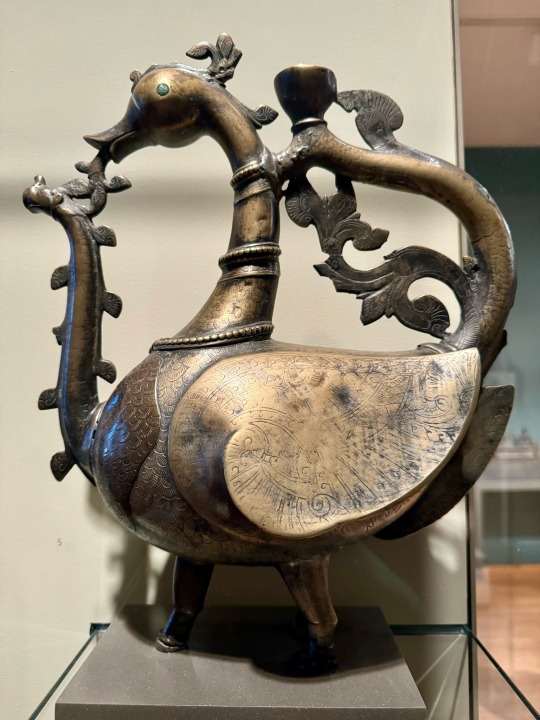
Ewer in the form of a Hamsa (Gander)
Indian, Deccan or Northern India, ca. 16th c.
Bronze with later brass repairs, copper-arsenic paste
H 15 3/16 in (38.5 cm)
on view at Museum of Fine Arts, Boston
“The body of this ewer takes the form of a goose (hamsa), another common motif in ancient Hindu and Buddhist iconography, where it is associated both with the waters of life, because of its aquatic nature, and with wisdom and purity, on account of its legendary ability to separate milk from water. The spout takes the form of a makara—a mythological aquatic creature that resembles a crocodile with an elephant’s trunk and a fish’s tail—another quintessentially South Asian motif and one of the most commonly used propitious emblems in Indian decorative art.
Other features of the ewer resonate more closely with Islamic artistic traditions, which came to South Asia with travelers and traders soon after the emergence of Islam itself in the seventh century CE. Thus, while vessels in the form of animals are quite rare in Indian metalwork before the Sultanate period (1206–1526), when Muslim-ruled kingdoms first controlled large areas of South Asia, zoomorphic ewers have a long history in Islamic metalwork going back to the eighth century CE. The hamsa ewer beautifully represents a confluence of motifs, mythologies, and objects that belong solely to neither Islamic nor Hindu cultural traditions. Indeed, it would have served equally well the needs of either a Muslim or a Hindu owner, facilitating the performance of ritual ablutions before religious observances within the home; or it may have been proffered by a servant at an elite banquet, enabling Muslim and Hindu guests alike to cleanse their hands before and after the meal.”
https://collections.mfa.org/objects/18461/ewer-in-the-form-of-a-hamsa-gander
#animals in art#museum visit#birds in art#bird#hamsa#gander#metalwork#bronze#ewer#Indian art#South Asian art#Asian art#Museum of Fine Arts Boston#16th century art
22 notes
·
View notes
Note
An entire chapter of Space Marines dedicated to having over the top Italian American accents and converse entirely in mafia speak, called the WISE GUYS
They're a Dark Angels successor chapter who have famously sent several inquisitors to "sleep with the fishes" after asking too many questions. You're overheard asking about The Fallen in an archive. The next day you receive a single brick, stamped with their chapter iconography, in the post. The day after that they show up at your house with holy piano wire and a large adamantine suitcase.
62 notes
·
View notes
Photo
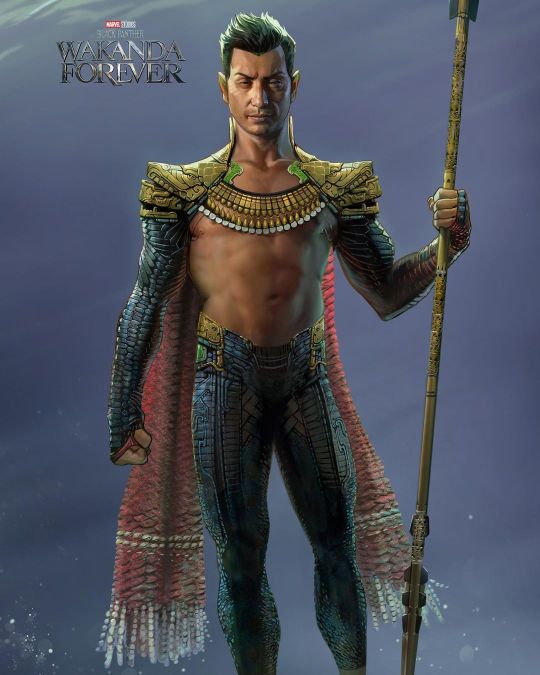
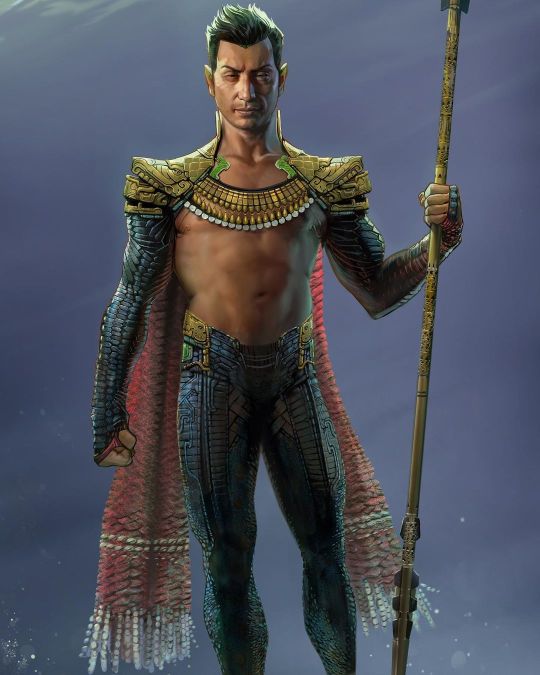

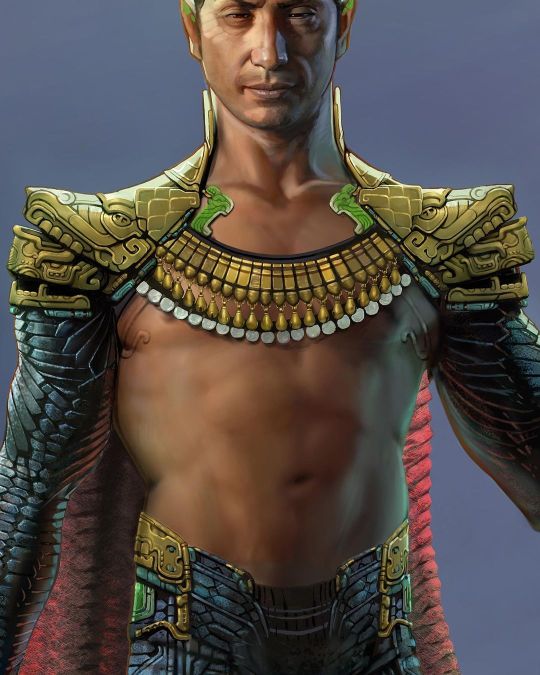


I was finally able to watch Wakanda Forever today and Namor might be my favorite new MCU character. In addition to my Marvel Animation duties, Ryan gave me a shot to help out on BP2. The ‘first read’ on this iteration of this costume was based on his Phoenix 5 comic design, the basic iconography of his black, red and gold graphic design . The scale patterning was taken mostly from a Viperfish which has a great black/silver shine and a subtle dash of red. Most of the red scale patterning comes from the Arapaima fish(please google both, they are super cool). When it came to researching I may have spend more time digging for Mayan artifacts and their meaning than I spent actually drawing and painting. The more I dug the more I felt like I was missing out. It was a bizarre feeling to have ‘Research Fomo’. According to the Mayan world model(at least the one I found) there is Itzamnaaj the Bird of Heaven that sits above the World Tree, you can find this on the back of his neck armor. And there are the “Jaws of the Underworld“ which you can find around Nämor’s hips(this isn’t as apparent in this iteration of the design, you’d see it more from the side). The large necklace is VERY close to an actual Mayan artifact with slight adjustments and additions of the pearls and rubber trim. The shrimp and crab detail on the middle of his back is also very close to a decorative Mayan mouth piece that hangs from the nose. Hopefully when the artbook is out I might be able to post the final Head Dress costume design... For the Phoenix 5 inspiration I used @kristaferanka’s drawing. 🔥 I believe the original comic design was by @johnromitajr ?
- Joshua James Shaw
#mcu namor#namor#namor the sub mariner#black panther: wakanda forever#art#concept art#costume design#costumes#joshua james shaw#phoenix namor
86 notes
·
View notes
Text






Hapi
Major cult center:Elephantine
Symbols:Amphora 𓎿 𓏂, Fertility, Hippopotamus, Lotus and Crocodiles (Upper Egypt), Papyrus plants and attended by frogs (Lower Egypt), Nile, Water
Connection to other gods:Geb (God of the earth), Neper (God of grain)
Priest names
(roles) priests were involved in rituals to ensure the steady levels of flow required from the annual flood. Located at Ta-Sety, Abu/Elephantine there was nilometer, a measuring device, was carefully monitored to predict the level of the flood, and his priests must have been intimately concerned with its monitoring.
Features
Hapy is show as an intersex person with a large belly and pendulous breasts, wearing a loincloth and ceremonial false beard. He is depicted with either blue or green skin, representing water. In Lower Egypt, he was adorned with papyrus plants and attended by frogs. In Upper Egypt, it was the lotus and crocodiles which were more present in the Nile. He is often pictured carrying offerings of food or pouring water from an amphora, but also, very rarely, was depicted as a hippopotamus. During the Nineteenth dynasty Hapy is often depicted as a pair of figures, each holding and tying together the long stem of two plants representing Upper and Lower Egypt, symbolically binding the two halves of the country around a hieroglyph meaning "union". Not to be confused with one of Horu's son Hapi by the same name.
Hapi (Ancient Egyptian: ḥʿpy) was the god of the annual flooding of the Nile in ancient Egyptian religion. The flood deposited rich silt (fertile soil) on the river's banks, allowing the Egyptians to grow crops. Hapi was greatly celebrated among the Egyptians. Some of the titles of Hapi were "Lord of the Fish and Birds of the Marshes" and "Lord of the River Bringing Vegetation". Hapi is typically depicted as an androgynous figure with a prominent belly and large drooping breasts, wearing a loincloth and ceremonial false beard.
Mythology
The annual flooding of the Nile occasionally was said to be the Arrival of Hapi. Since this flooding provided fertile soil in an area that was otherwise desert, Hapi symbolised fertility. He had large female breasts because he was said to bring a rich and nourishing harvest. Due to his fertile nature he was sometimes considered the "father of the gods",and was considered to be a caring father who helped to maintain the balance of the cosmos, the world or universe regarded as an orderly, harmonious system. He was thought to live within a cavern at the supposed source of the Nile near Aswan. The cult of Hapi was mainly located at the First Cataract named Elephantine. His priests were involved in rituals to ensure the steady levels of flow required from the annual flood. At Elephantine the official nilometer, a measuring device, was carefully monitored to predict the level of the flood, and his priests must have been intimately concerned with its monitoring.
Hapi was not regarded as the god of the Nile itself but of the inundation event. He was also considered a "friend of Geb", the Egyptian god of the earth, and the "lord of Neper", the god of grain.
Roles
Hapi is an intersexed god, who is probably shown this way to represent the fertility of the nile's annual flood. He is not considered the God of the Nile , but represent the annual flooding of the Nile and inundation event called the Arrival of Hapi. Hapi maintain the balance of the cosmos. He was sometimes considered the Father of the Gods because of his fertile.
Iconography
Although male and wearing the false beard, Hapi was pictured with pendulous breasts and a large stomach, as representations of the fertility of the Nile. He also was usually given blue or green skin, representing water. Other attributes varied, depending upon the region of Egypt in which the depictions exist. In Lower Egypt, he was adorned with papyrus plants and attended by frogs, present in the region, and symbols of it. Whereas in Upper Egypt, it was the lotus and crocodiles which were more present in the Nile, thus these were the symbols of the region, and those associated with Hapi there. Hapi often was pictured carrying offerings of food or pouring water from an amphora, but also, very rarely, was depicted as a hippopotamus. During the Nineteenth Dynasty Hapi is often depicted as a pair of figures, each holding and tying together the long stem of two plants representing Upper and Lower Egypt, symbolically binding the two halves of the country around a hieroglyph meaning "union".This symbolic representation was often carved at the base of seated statues of the pharaoh.[ Egyptian historian Al Maqrizi (1364–1442) related in his "El Khutat El Maqrizia (The Maqrizian Plans) that living virgins were sacrificed annually as "brides of the Nile" ("Arous El Nil") and this has been historically accepted as late as the 1970s. but this claim is disputed by some Egyptologists such as Bassam El Shammaa.
──────⊰In Workings⊱──────
*Please know basic protections and energy work before attempting any deity work.*
*It is important to note that everyone's experiences are different and will work with spirits for different reasons. Some people may like a spirit while others will not and that's okay. Ask these spirits what they will work with you on as well as ask them if they can help you with whatever it is you need.*
Ideas for honoring or working with/worshipping Hapi
Altar
Create an altar/sacred space for your rituals and giving offerings for Hapi. Items may include
⬩An altar cloth
⬩Blue candles (you can use any color)
⬩Cup or chalice
⬩Incense and an incense burner
⬩Offering bowl
⬩Statue of Hapi
For more information on basic deity work and altar setups check out the deity work post.
Basic offerings:Bread, Frankincense, Game Meat, Lion Statue Myrrh, Sour Dough, Meat, Sun Symbols,
Ritual
Ideas for rituals may include
⬩Fertility rites
⬩Maintaining balance
⬩Maintaining steady levels from the flood
⬩Ask him what else he can help you on⬩
The Hymn to the Flood
Lightmaker who comes from the dark Fattener of herds Might that fashions all None can live without him People are clothed with the flax of his fieldsThou makest all the land to drink unceasingly, as thou descendest on thy way from the heavens.
𓈖𓈖𓈖𓈖𓈖𓈖𓈖𓈖𓈖𓈖𓈖𓈖𓈖𓈖𓈖𓈖𓈖

For more content relating to other practices/religions or pantheons follow my main blog for updates
If you have any more questions or wish to join a community feel free to join my 18+ discord server
Ask me anything on my blog
#Hapi#kemetism#occult#witchcraft#witchblr#deity#pagan#paganism#Kemeticism#neterism#neter#netjer#neteru#netjeru#kemetic#kemetic pagan#kemetic paganism#kemetic polytheism#kemetic witch#pagan witch#witch#baby witch#baby pagan#occultism#occultblr#paganblr#kemetblr
20 notes
·
View notes
Text
84th Sigman Kerberos Regiment, aka The Wolf Brigade
The story of how they Earned that nickname.
In the 42nd Millennium, after the Fall of Cadia, In the Imperium Nihilis, A company of the Wolfspear Chapter was under assault by a fleet of Chaos Reivers led by a Single Ship of Huron Blackhearts own Red Corsairs.
Their Battle Barge crippled and the enemy ships circling like sharks, they prepared to go down fighting. The Red Corsair then fired some Ursus Claws into the Battle Barge and began reeling them in like a fish on a line for a Boarding Action.
Then a small Rouge Trader Fleet drops out of the Warp. After hailing the Wolfspears to confirm their Loyalty, the Traders escort ships break off and begin harassing the Chaos Reivers. Meanwhile the Massive Rouge Trader ship makes a b-line for the Red Corsair firing all its forward weaponry.
The Red Corsair, currently in the middle of boarding the Wolfspear Battle Barge, then found itself being boarded by numerous Valkyre Drop ships loaded with Tempestus Scions.
The Corsairs Traitor Astartes soon found the tables had turned as they now fought a two front war against their former prey the Wolfspears and thier new attackers, the Scions. With this newfound breathing room and smelling blood in the water, the Wolfspears pressed the counter attack. Repelling the Corsairs from their Battle Barge the Wolfspears continued on into the belly of the Red Corsairs Vessel. It was there that they Met the 84th Sigman Kerberos.
After a quick parlay wherein each side confirmed the Loyalty Status of the other, the Scions and Astartes quickly began coordinating their efforts to Assault the enemy vessel and its crew. With their combined efforts they managed to place explosive charges throughout the Corsair in its most vulnerable areas.
The Scions and Astartes then exfiltrated the Corsair and returned to the Battle Barge. Once everyone was on board, save a single 5 man fireteam of Scions left as a sacrificial rear guard, the explosives were detonated and the Corsair was reduced to space debris.
Their Red Corsair Flagship destroyed, the rest of the Chaos Reivers scattered and fled.
The Rouge Trader Fleet then enveloped the battle barge as numerous teams of squat engineers begin making repairs to the vessel. Meanwhile the Rouge Trader begin offloading numerous supplies and equipment to the Battle Barge.
The Rouge Trader's Squat Captain and the Scions Tempestor Prime report to the Wolfspear Captain that Rouge Traders mission was to deliver the Scions as reinforcements to the first Loyalist Imperial authority they encountered in the Imperium Nihilis. This just so happened to be the Wolfspears.
Thus 3 companies of the 84th Sigman Kerberos Regiment were attached to that Company of the Wolfspear Chapter of Adeptus Astartes.
After 9 years of service with distinction, of the original 3 companies, only 4 Platoons are left. In recognition of their deeds in Aid to the Wolfspear Chapter, the remaining Platoons are sent back to Ørnverden with the Chapters blessing to add the Wolfspears Iconography to the Regiments Heraldry. The Wolfspears Captain also gives them the honorary title of "the Wolf Brigade"
#homebrew regiment#homebrew#imperial guard#tempestus scions#adeptus astartes#Wolfspear Chapter#warhammer 40k#40k
29 notes
·
View notes
Text
I have made a fascinating discovery!
I was flipping through my encyclopedia of spirits and came across a Polynesian God named "Ku"
Yep. Ku.
Needless to say, I read the entry, and I think it's plausible that Octopath Traveler II took some inspiration from this diety! I'll attach a photo copy of the text and a transcription below.
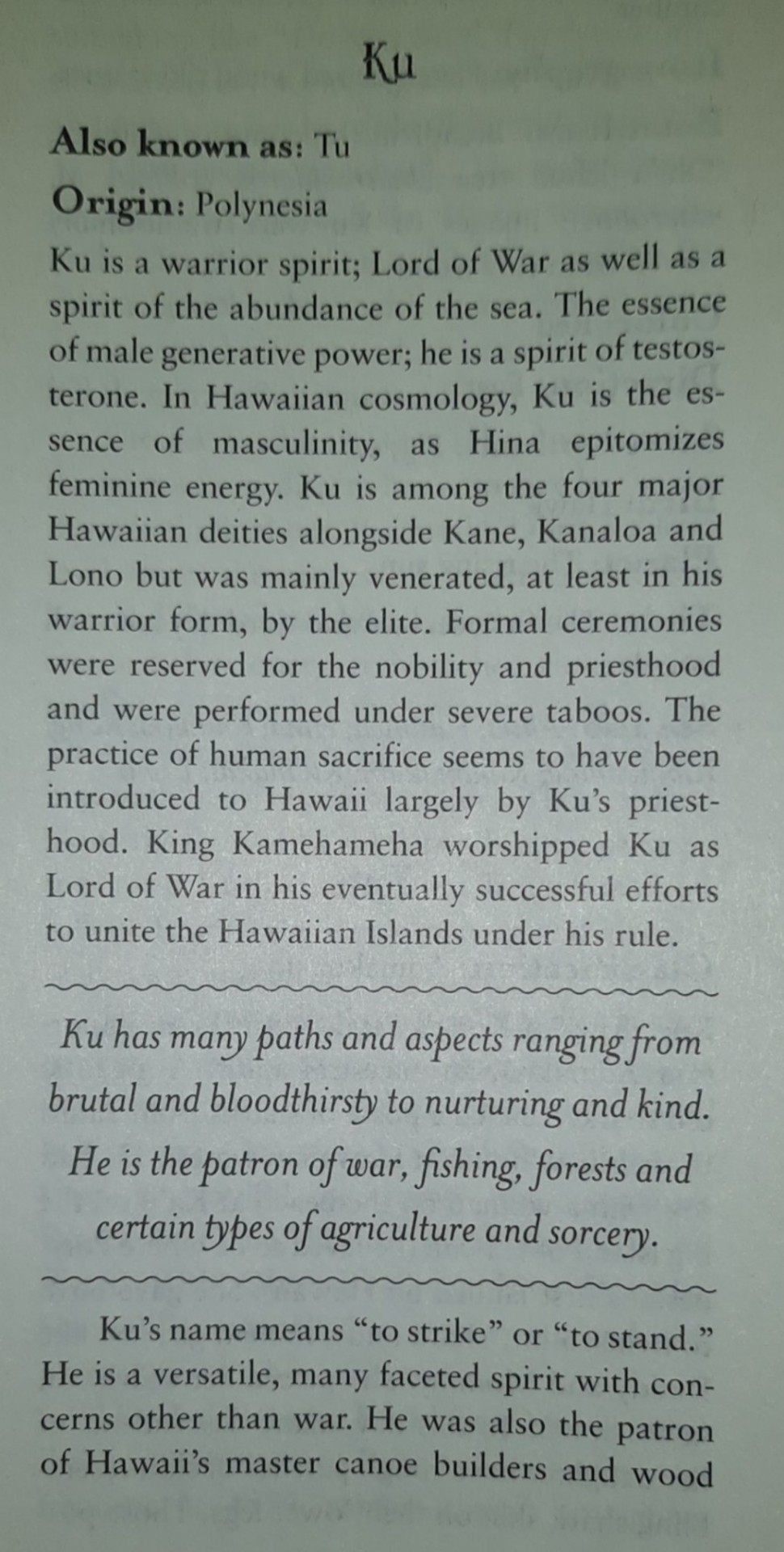
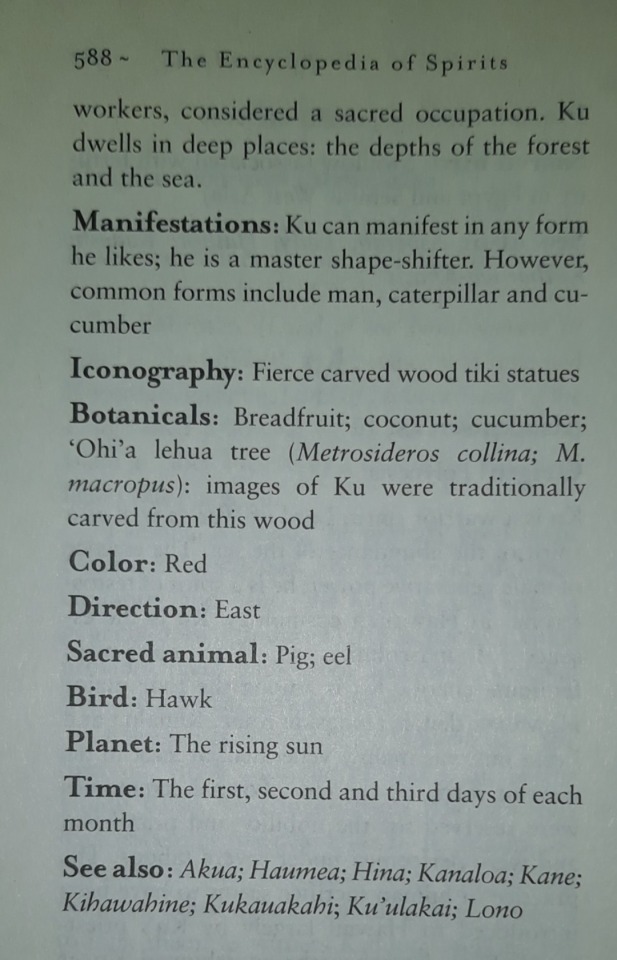
-----------------------------------------------
The first page reads as follows...
Ku
Also known as: Tu
Origin: Polynesia
Ku is a warrior spirit; Lord of War as well as a spirit of abundance of the sea. The essence of male generative power; he is the spirit of testosterone. In Hawaiian cosmology, Ku is the essence of masculinity, as Hina epitomizes feminine energy. Ku is among the four major Hawaiian deities alongside Kane, Kanaloa and Lono but was mainly venerated, at least in his warrior form, by the elite. Formal ceremonies were reserved for the nobility and priesthood and were performed under severe taboos. The practice of human sacrifice seems to have been introduced to Hawaii largely by Ku's priesthood. King Kamehameha worshiped Ku as Lord of War in his eventually successful efforts to unite the Hawaiian Islands under his rule.
Ku has many paths and aspects ranging from brutal and bloodthirsty to nurturing and kind. He is the patron of ear, fishing, forests and certain types of agriculture and sorcery.
Ku's name means "to strike" or "to stand." He is a versatile, many faceted spirit with concerns other than war. He was also the patron of Hawaii's master canoe builders and wood—
-----------------------------------------------
The second page reads as follows...
workers, considered a sacred occupation. Ku dwells in deep places: the depths of the forest and the sea.
Manifestations: Ku can manifest in any form he likes; he is a master shape-shifter. However, common forms include man, caterpillar, and cucumber
Iconography: Fierce carved wood tiki statues
Botanicals: Breadfruit; coconut; cucumber: 'Ohi'a lehua tree (Metrosideros collina; M. macropus): images of Ku were traditionally carved from this wood
Color: Red
Direction: East
Sacred animal: Pig; eel
Bird: Hawk
Planet: The rising sun
Time: The first, second and third days of each month
See also: Akua; Haumea, Hina; Kanaloa, Kane; Kihawahine; Kukauakahi; Ku'ulaki; Lono
-----------------------------------------------
It's almost impossible not to see the parallels here! This book is called Encyclopedia of Spirits: the ultimate guide to the magic of fairies, genies, demons, ghosts, gods & goddesses by Judika Illes for those who are curious! ^^
#octopath traveler 2#octopath traveler ii#hikari ku#polynesian#polynesian mythology#ginger's scholarly pursuits
26 notes
·
View notes